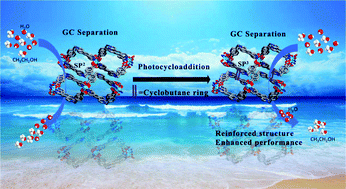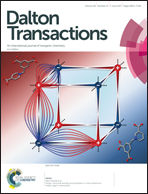Post-cycloaddition modification of a porous MOF for improved GC separation of ethanol and water†
Abstract
An olefin-containing pyridinium derivative, 1-(4-carboxybenzyl)-4-[2-(4-pyridyl)-vinyl]-pyridinium chloride (HBCbpeCl) has been introduced into a novel 2D metal–organic framework with rare right- and left-handed spiral nanotubular channels arranged alternately in the structure. The 1D channel is modified by positively-charged pyridinium segments, which shows high affinities to Lewis basic molecules such as methanol, ethanol, and water vapor. Additionally, the BCbpe molecules in the structure have been directed through cation–π interactions to be aligned antiparallel to each other with the C![[double bond, length as m-dash]](https://www.rsc.org/images/entities/char_e001.gif) C double bond arranged properly for [2 + 2] photocycloaddition, which can be triggered to undergo structural transformation from 2D to 3D. This post-cycloaddition modification strategy has been used to separate alcohols and water, which includes a successful adjustment of large tailor-made channels by the [2 + 2] cycloaddition reaction. The gas-chromatographic separation experiments show that ethanol can be better separated from water through a column filled with a post-cycloaddition modified sample than the as-synthesized one.
C double bond arranged properly for [2 + 2] photocycloaddition, which can be triggered to undergo structural transformation from 2D to 3D. This post-cycloaddition modification strategy has been used to separate alcohols and water, which includes a successful adjustment of large tailor-made channels by the [2 + 2] cycloaddition reaction. The gas-chromatographic separation experiments show that ethanol can be better separated from water through a column filled with a post-cycloaddition modified sample than the as-synthesized one.



 Please wait while we load your content...
Please wait while we load your content...